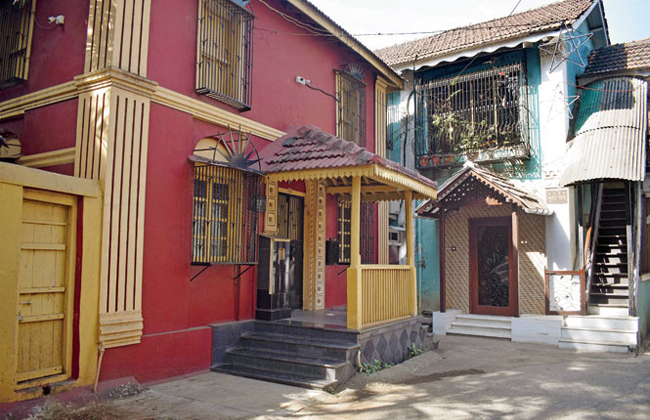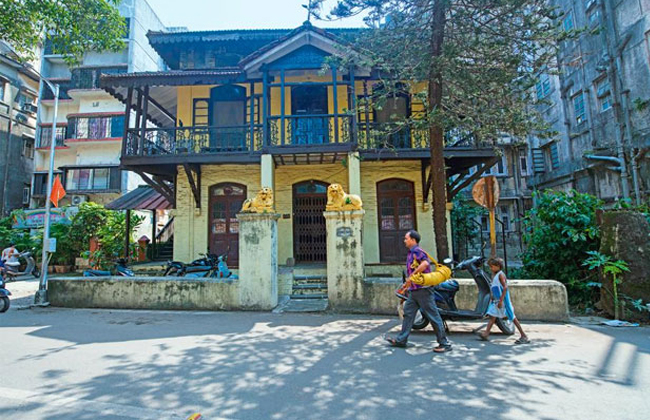

The sleepy little village Matharpacady of Mazgaon was one of the original seven islands of Mumbai and was an ancient Portuguese township. During the Portuguese rule in Mumbai from 1534-1661, many "East Indian" villages came up and the fishing folk came up with distinctive Portuguese architecture. Nestled in the heart of Mazgaon atop an old hillock, Matharpacady was home to the city's first Indian mayor Dr M U Mascarenhas. The Sir JamsetjiJeejeebhoy Mansion, which now functions as the Sales Tax office, was built adjacent to the village for the country's first Indian Baron. "At first, the area was home to the wealthy and famous of Bombay. The village's history is even richer than precincts like Khotachiwadi. However, this declined as the who's who moved to other parts of south Mumbai," The name 'Matharpacady' stems from the Sanskrit word 'Mathara' which means 'wise one', he said. "This is what the Portuguese called their arbitrators who were known as 'vereodores'. In return for their services to the Portuguese government, they were given parcels of land; Matharpacady was one such land given to an arbitrator in the 1820s." Other stories suggest that it either stems from the Marathi meaning of the words Mathar and Pakkadi that are used to describe a 'cluster of dwellings on the forehead (hillock)', or the Portuguese meaning of 'oart' meaning "garden of orchards".
There is more to the sweetness of Matharpacady villagers than meets the eye — their Portuguese-influenced bungalows in Mazgaon goathan were constructed in the late 1800s using sugar and jiggery. This is one of the many lesser known factoids of the 300-year-old village that has 61 bungalows and is home to 160 families. Matharpacady village is self-contained with houses and altars. It boasts of some of the city’s oldest and quaintest houses. They were stone houses and wooden bungalows inhabited mainly by "East Indian" (Indo-Portuguese) people of Marathi descent. These houses had tiled roofs and were colourful structures with open verandahs. A few of them remain even now and they are great examples of Indo-Portuguese architecture that the Portuguese left behind as their legacy.
"The mango trees from Ambawadi, which was once an adjoining part of the precinct, flowered twice a year. There are documents to show that the mangoes from this neighbourhood were transported to the court of the Mughal Emperor Shah Jahan," These mangoes were a celebrated commodity, and the Mazgaon mangoes find a mention as the ‘Mangoes of Mazagong’ in the epic poem LallahRookh by Thomas Moore in 1817.
Visit a typical Indian home to enjoy traditional East Indian refreshment at Baptista's home, jointly stirred up by him and his mother Marie, over homemade snacks, tea, and coffee, soft drinks & coconut cake
Tour Duration: 1 hr 30 mins
Driving time from city hotel : 25 mins
Driving time from Suburb hotel : 1 hr 30 mins
TOUR HIGHLIGHTS :
- Travel in A/C deluxe vehicle with experienced drivers
- Monument entrances for all the monuments
- English speaking friendly guide
- Mineral water bottle
- Snacks @ local home
TOUR DATE: Feb 06th- 12th Feb 2023 (Everyday)
COST: INR 9,500 per person (Minimum of 02 guests)| INR 6,900 per person (Minimum of 08 guests) | INR 5,800 per person (Minimum of 14 Guests)
TIME: 0900 hrs from the Nehru Centre (Tour will end at 1700 hrs - 03 hours Tour)
Note: The above cost is exclusive of 5% GST.

Please send your booking request for above tours or any customized tour to undersigned:
For any queries contact
Mr. Neeraj Jaggi
Phone: +91-9810658724
Email: hospitality@mec-9.com, neeraj.jaggi@MEC-9.com
